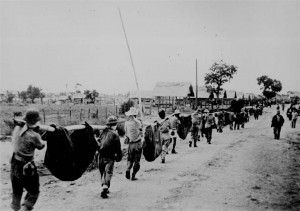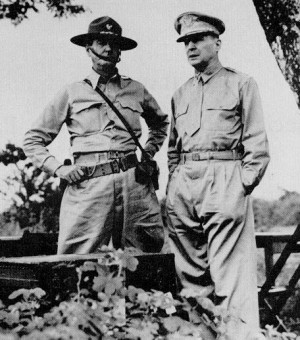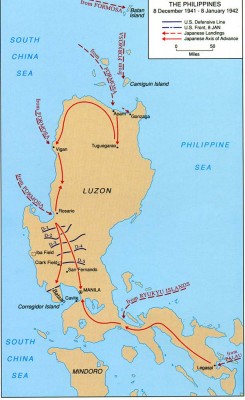 The Philippines Campaign (1941-1942), was an invasion of the Philippines by Japan also known as the Battle of the Philippines. The islands were a strategic location for the Japanese as they lie between Japan and the South Pacific. The importance of this location forced the United States to call Army General Douglas MacArthur, who had retired in the Philippines, to serve in the Filipino Army as a field marshal.
The Philippines Campaign (1941-1942), was an invasion of the Philippines by Japan also known as the Battle of the Philippines. The islands were a strategic location for the Japanese as they lie between Japan and the South Pacific. The importance of this location forced the United States to call Army General Douglas MacArthur, who had retired in the Philippines, to serve in the Filipino Army as a field marshal.
Background
The Empire of Japan declared war upon the United States of America in 1941. Shortly after this, the Japanese invaded the Philippines, a collection of islands in South East Asia which was home to a number of important U.S. army bases at the time. This invasion started only ten hours after the attack on Pearl Harbor. Though the American-Filipino army was defeated by the Japanese invaders during April the following year, guerrilla resistance continued throughout the war, increasing over the years. This eventually led to the liberation of the Philippine Islands during 1944.
Japan”s Objectives
The Emperor of Japan believed that all Asian countries rightfully belonged to the Imperial Japanese government. The invasion of neighboring countries such as Korea and China started taking an immediate upswing during the 20th century. Taking over the neighboring Asian countries was part of the “Greater Asian War” plan of Japan. However, to achieve their goal, they had to attack the countries which had the presence of foreign military forces. The Dutch had the East Indies, The United Kingdom were present in Hong Kong and Malaysia, and the United States had military bases in the Philippines.
Japan had three main objectives for the invasion. First, they wanted to prevent the operations of the United States military force in the Philippines. Second, they wanted to acquire land in different islands in order to strategically attack the Dutch in the East Indies. Lastly, they wanted to secure communication lines between Japan and neighboring countries that have been successfully invaded.
Defenses
 MacArthur organized the U.S. Army Forces in the Far East into four different commands. The North Luzon Force was commanded by Major General Jonathan M. Wainwright and had troops located in areas that were prone to amphibious attack as well as central provinces. The South Luzon Force covered the Southern and Eastern areas of Luzon. This was activated on December 13, 1941 and was under Brigadier General George M. Parker Jr. The Visayan-Mindanao Force was commanded by Brigadier General William F. Sharp and was activated shortly after the South Luzon Force. The USAFFE Reserve Force was positioned right above Manila and was under the direct command of General MacArthur. It was composed of the Philippines 91st Division with coastal artillery regiments from the U.S. guarding the entrance to Manila Bay and Corregidor Island.
MacArthur organized the U.S. Army Forces in the Far East into four different commands. The North Luzon Force was commanded by Major General Jonathan M. Wainwright and had troops located in areas that were prone to amphibious attack as well as central provinces. The South Luzon Force covered the Southern and Eastern areas of Luzon. This was activated on December 13, 1941 and was under Brigadier General George M. Parker Jr. The Visayan-Mindanao Force was commanded by Brigadier General William F. Sharp and was activated shortly after the South Luzon Force. The USAFFE Reserve Force was positioned right above Manila and was under the direct command of General MacArthur. It was composed of the Philippines 91st Division with coastal artillery regiments from the U.S. guarding the entrance to Manila Bay and Corregidor Island.
Controversy of the Far East Air Force
Pearl Harbor was attacked just ten hours before the invasion of the Philippines at 3:00 am, local time. Even before this news, there was an air search conducted due to unauthorized aircrafts which were reported to have just been Japanese weather planes. Bombers landed at Clark Airfield, Pampanga at 10:00 am that day. During the 45-minute attach, the FEAF lost nearly half the planes in the base, and was left destroyed within a week. The remaining aircrafts of the FEAF in the Philippines were captured by Japanese forces. This failure did not undergo any formal investigation as troops were still shocked by the occurrences in Pearl Harbor. Major General Emmitt O”Donnell said it was not anyone”s fault, but the U.S. forces failed to assess the efficiency and speed of the Japanese Air Force.
Japanese invasion
The 14th Army of the Empire of Japan landed on Batan Island, which marked the start of the invasion. The island was located just off the coast of northern Luzon. Other landings in northern Luzon were seen later that same week. On December 14, the 16th Division of the Japanese army unloaded 2,500 men in southern Luzon at Legazpi. This was only 240 km away from the closest American base. Mindanao was attacked seven days after the landing at Legazpi.
Battle of Bataan
This battle is known as an intense, three-month battle initiated by the Imperial Army of Japan. The fall of Bataan into Japanese hands hastened the collapse of U.S. forces in Corregidor. The base was compromised on April 9, 1942 after the surrender of General Edward P. King to Japanese forces when an estimated 60,000 to 80,000 prisoners of war both Filipino and American were captured. This lead to the infamous Bataan Death March, where the POWs were forced to walk from Bataan to Balanga, locations that were 128 km apart. This event was characterized by murder, abuse, and other atrocities suffered by the Filipinos and Americans.
Battle of Corregidor
 The island of Corregidor was a good position for artillery as it defended the opening of Manila Bay. Many of the Philippines” high ranking officers, different diplomats, and notable families were housed in Malinta Tunnel of Corregidor, after escaping the bombings that took place in Manila. Wainwright assumed control of the Philippine forces after MacArthur fled from Bataan to Australia. The defense on Malinta Hill was pushed back so, by May 6th, Wainwright asked the Japanese Force for terms of surrender, fearing for those who were in Corregidor. All allied forces in the Philippines surrendered after this. However, many guerilla activities continued.
The island of Corregidor was a good position for artillery as it defended the opening of Manila Bay. Many of the Philippines” high ranking officers, different diplomats, and notable families were housed in Malinta Tunnel of Corregidor, after escaping the bombings that took place in Manila. Wainwright assumed control of the Philippine forces after MacArthur fled from Bataan to Australia. The defense on Malinta Hill was pushed back so, by May 6th, Wainwright asked the Japanese Force for terms of surrender, fearing for those who were in Corregidor. All allied forces in the Philippines surrendered after this. However, many guerilla activities continued.
Aftermath
The surrender of Corregidor marked the beginning of three years of horror for the survivors. However, the Philippine islands were eventually liberated along with the POWs. The news about the Death March in Bataan did not reach the United States until January 27, 1944 which aroused anger and fury within America. The allied forces of the Filipino and United States army continued to share a diplomatic relationship throughout the duration of the war.